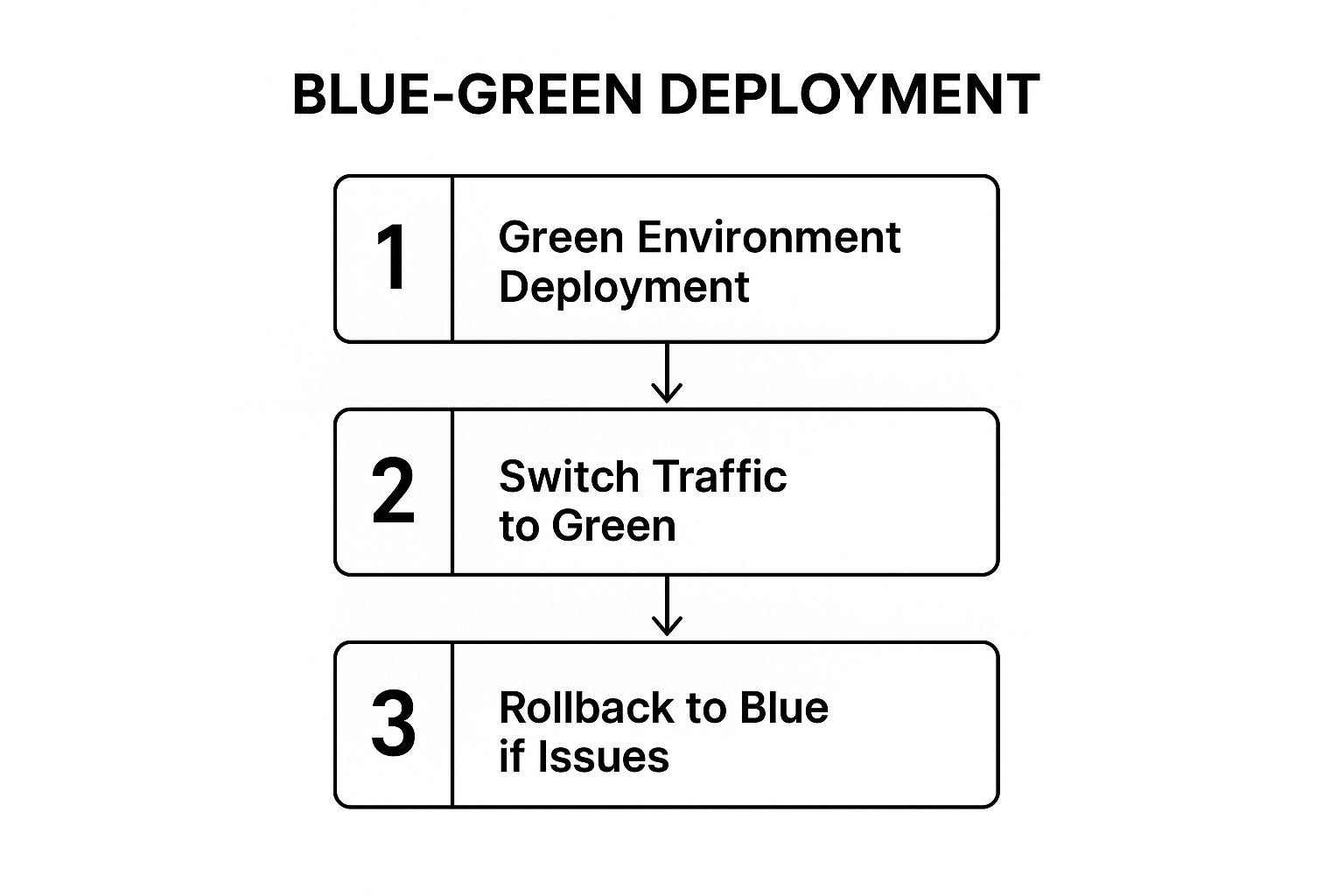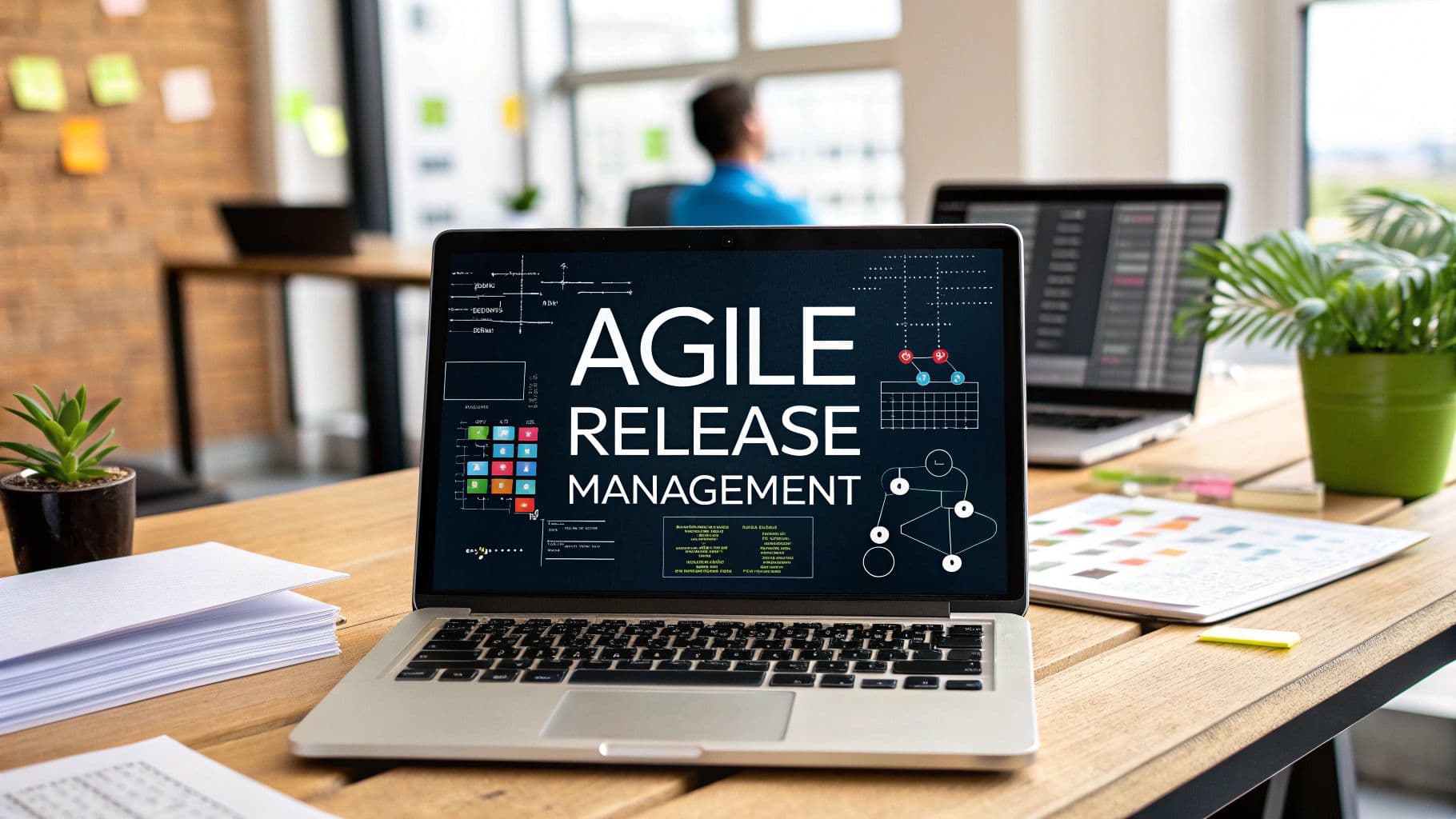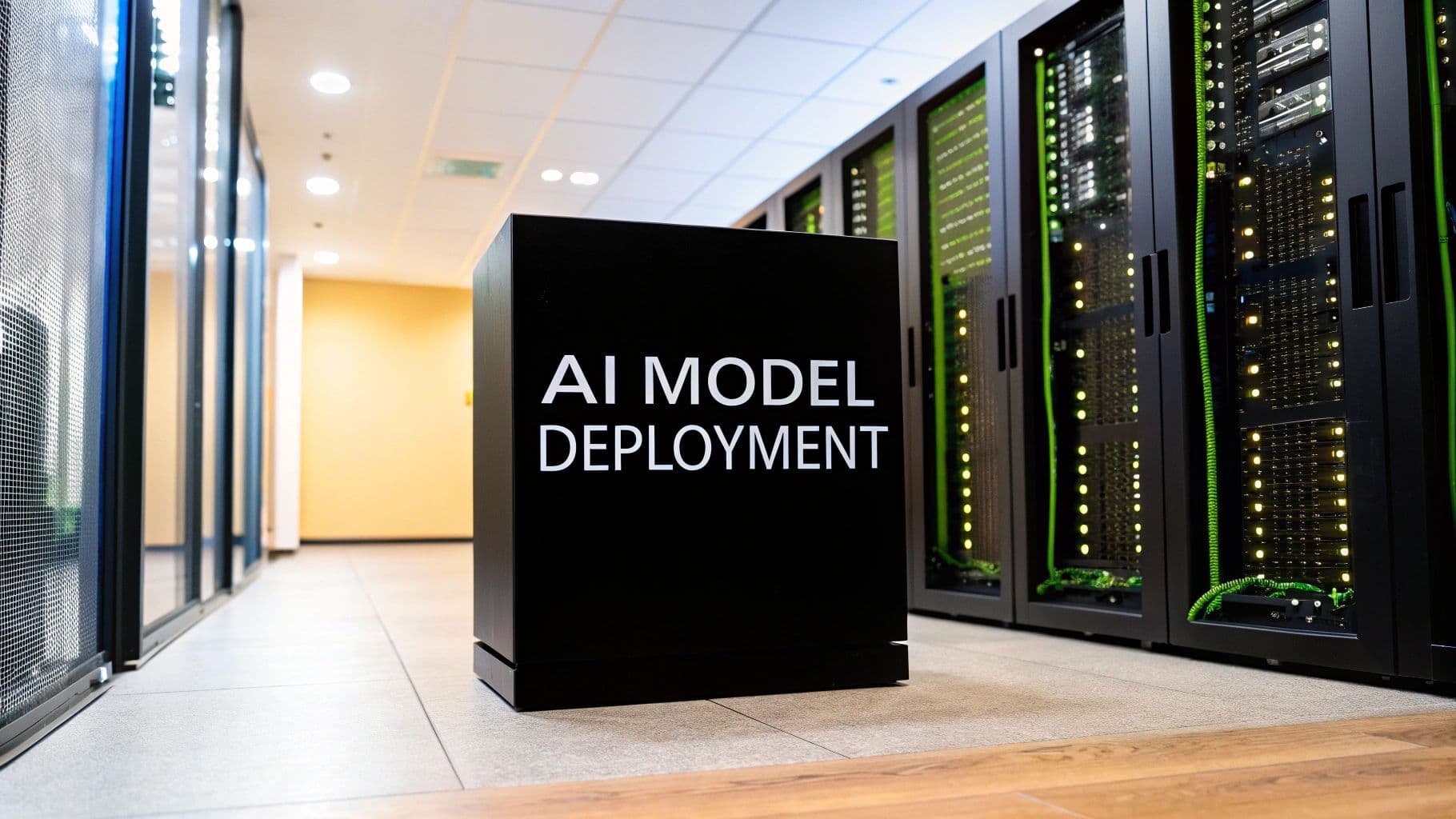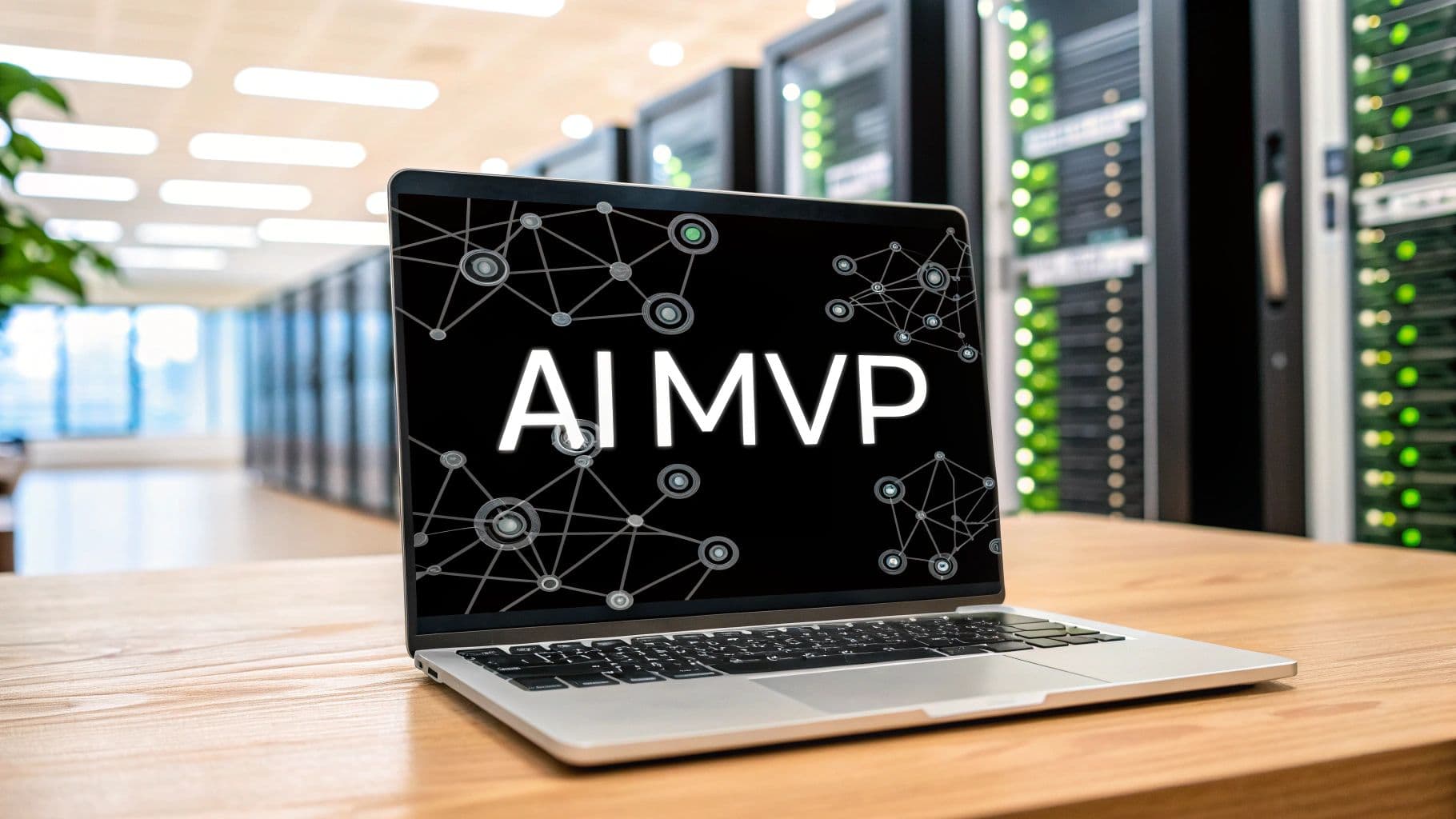ci/cd best practices
DevOps
Software Delivery
Deployment Pipeline
Automation
Top CI/CD Best Practices for Fast, Reliable Releases
Turbocharge Your Delivery Pipeline: Essential CI/CD Best Practices
This listicle presents nine crucial CI/CD best practices to optimize your software delivery process. Implementing these practices will help you achieve faster release cycles, reduce errors, and improve overall software quality. Whether you're building a small app or a complex system, mastering these CI/CD best practices is essential for maintaining a competitive edge. We'll cut through the noise and focus on actionable advice you can implement immediately. This isn't a theoretical overview; it's a practical guide to building better pipelines.
This article explores critical CI/CD best practices, providing specific and actionable advice for immediate implementation. We'll cover:
- Foundational Practices: Version control integration, automated testing, and Infrastructure as Code (IaC)
- Advanced Techniques: Fast feedback loops, blue-green and canary deployments, and integrating security (DevSecOps)
- Pipeline Optimization: Pipeline as Code, monitoring and observability, and artifact management with immutable deployments
By focusing on these core CI/CD best practices, you’ll gain a strong foundation for building robust and efficient delivery pipelines. This will lead to increased developer productivity and faster time to market for your projects. We'll equip you with the knowledge to streamline your workflows, minimize risks, and create a truly agile development environment. Learn how to build a better pipeline and deliver software more effectively.
1. Version Control Integration
Robust CI/CD pipelines rely on version control systems (VCS) like Git as their bedrock. Integrating version control isn't just about storing code; it's about triggering automated processes with every change. This ensures every modification is tracked, reproducible, and ready for automated testing and deployment through integrated workflows. This foundational practice enhances collaboration, streamlines development, and forms the core of effective CI/CD.

Imagine a scenario where a developer pushes a code update. With proper VCS integration, this simple act automatically initiates a series of checks and balances. The code is automatically tested, built, and potentially even deployed, all without manual intervention. This is the power of a well-integrated version control system in a CI/CD pipeline. Learn more about Version Control Integration
Examples of Effective VCS Integration
- GitHub Actions: Directly integrated with repositories, allowing workflows triggered by events like pushes, pull requests, or releases.
- GitLab CI/CD: Built-in pipelines triggered by merge requests and other Git events, streamlining the entire development process.
- Bitbucket Pipelines: Enables automatic deployments and other automated actions based on repository activity.
Actionable Tips for VCS Integration
- Meaningful Commit Messages: Use clear, concise commit messages with ticket references to enhance traceability and collaboration. This makes understanding code changes much easier for the whole team.
- Branch Protection Rules: Implement rules to prevent direct commits to critical branches like
mainordevelop, ensuring code quality and stability. This enforces code reviews and prevents accidental overwrites. - Automated Testing on Feature Branches: Integrate automated tests into feature branch workflows. This ensures that bugs are caught early, before they reach production.
- Semantic Versioning: Use semantic versioning (SemVer) for releases to communicate changes effectively and manage dependencies reliably. This clarifies the impact of each release for users and downstream systems.
This approach is crucial for anyone involved in software development, from independent developers to enterprise teams, maximizing efficiency and quality. By leveraging version control as the core of your CI/CD, you are building a foundation for rapid iteration and reliable deployments.
2. Automated Testing at Multiple Levels
Robust CI/CD pipelines rely heavily on automated testing at multiple levels. This comprehensive testing strategy incorporates unit tests, integration tests, end-to-end tests, and security tests, all executed automatically within the CI/CD workflow. This layered approach ensures code quality by catching issues early in the development process, minimizing the risk of bugs reaching production. Thorough testing strengthens the reliability of each release, contributing to a more stable and robust application.

Imagine a scenario where a developer introduces a bug affecting a critical user flow. With a multi-level automated testing strategy, this bug would be detected during the automated testing phase, preventing it from reaching users. This rapid feedback loop allows for faster remediation and prevents costly issues in production. Learn more about Automated Testing at Multiple Levels
Examples of Effective Multi-Level Testing
- Netflix: Their microservice architecture necessitates comprehensive testing across individual services and their interactions.
- Spotify: They maintain high code coverage through an extensive automated testing pipeline, ensuring a stable and reliable user experience.
- Amazon: Their multi-tier testing approach ensures the reliability and scalability of AWS services.
Actionable Tips for Multi-Level Testing
- Follow the Test Pyramid Principle: Prioritize unit tests, followed by integration tests, and finally, a smaller number of end-to-end tests. This ensures efficient resource allocation and effective bug detection.
- Run Fast Tests First: Execute faster tests like unit tests early in the pipeline to identify basic errors quickly. This optimizes pipeline execution time and provides rapid feedback.
- Implement Test Parallelization: Run tests concurrently to significantly reduce overall testing time and accelerate the feedback loop. This is crucial for maintaining rapid development cycles.
- Use Test Doubles and Mocking: Isolate components under test using mocks and stubs to simulate dependencies and focus on specific functionalities. This increases test reliability and simplifies test setup.
- Set Up Quality Gates: Implement quality gates based on test coverage, code quality metrics, and other relevant criteria to automatically prevent deployments of code that doesn't meet predefined standards. This ensures consistent code quality and prevents regressions.
This layered approach to testing is vital for ci/cd best practices, allowing for early bug detection, faster development cycles, and higher quality releases. Implementing automated testing at multiple levels, regardless of team size or project complexity, is a crucial step in building robust and reliable software.
3. Infrastructure as Code (IaC)
Robust CI/CD pipelines thrive on automation, and this extends beyond just the application code. Infrastructure as Code (IaC) takes this a step further, managing and provisioning infrastructure through code rather than manual processes. This enables consistent, repeatable, and version-controlled infrastructure deployments. IaC treats infrastructure the same way as application code, subjecting it to the same rigorous quality controls and automation. This consistency minimizes human error and ensures environments remain predictable and reliable.
Imagine a scenario where a team needs to deploy a complex application across multiple environments. With IaC, defining and deploying the necessary infrastructure becomes automated and streamlined. This eliminates the need for time-consuming manual configuration and ensures every environment is configured identically, minimizing deployment-related issues.
Examples of Effective IaC Implementation
- Airbnb: Utilizes Terraform for managing its extensive multi-cloud infrastructure, enabling efficient scaling and resource management.
- Capital One: Leverages AWS CloudFormation for automating infrastructure provisioning within its AWS ecosystem.
- Uber: Employs Terraform and Ansible for automating infrastructure management, enhancing consistency and scalability.
Actionable Tips for IaC Adoption
- Start Small: Begin with simple, non-critical environments to gain experience and refine your IaC practices.
- Modular Design: Use modular and reusable code patterns to improve maintainability and reduce redundancy. This facilitates efficient updates and simplifies infrastructure management.
- State Management: Implement robust state management to track infrastructure changes and ensure consistency across deployments. This ensures that infrastructure remains in a known and predictable state.
- Security Scanning: Integrate security scanning tools to identify vulnerabilities within your IaC templates. This proactive approach minimizes security risks and ensures compliance.
- Dedicated Repositories: Utilize separate repositories specifically for infrastructure code to enhance version control and maintainability. This keeps infrastructure code independent and manageable.
IaC is crucial for organizations aiming to streamline deployments, enhance reliability, and reduce operational overhead. By incorporating IaC into your CI/CD pipeline, you empower your team to manage infrastructure with the same efficiency and control applied to application code. This approach significantly improves agility, consistency, and scalability within the entire development lifecycle.
4. Fast Feedback Loops
Robust CI/CD pipelines thrive on speed. Fast feedback loops are crucial, providing developers with near-instant information about the impact of their code changes. This rapid feedback cycle, ideally within minutes, enables quick iteration and prevents small issues from snowballing into major problems. This accelerates the development process and fosters a culture of continuous improvement.

Imagine a developer pushing a code update and receiving automated test results within minutes. This allows for immediate correction if necessary, drastically reducing the time spent on debugging and troubleshooting. Fast feedback loops empower developers to make informed decisions quickly, contributing to a more efficient and effective development lifecycle. Companies like Google and Facebook prioritize rapid feedback in their internal CI/CD systems, demonstrating the value of this practice.
Examples of Effective Fast Feedback Loops
- Google's Internal Systems: Reportedly provide feedback to developers in under 10 minutes, allowing for rapid iteration and issue resolution.
- Facebook's Continuous Deployment: Emphasizes fast feedback cycles as a core component of their deployment strategy, facilitating multiple deployments per day.
- Etsy's Deployment Pipeline: Known for its speed, enabling frequent releases and quick responses to user feedback.
Actionable Tips for Implementing Fast Feedback Loops
- Optimize Build Caching Strategies: Leverage build caching to avoid redundant computations, significantly reducing build times.
- Parallelize Independent Tasks: Run tests and other build processes concurrently whenever possible to maximize resource utilization.
- Use Incremental Builds and Testing: Only rebuild and retest the portions of the codebase affected by recent changes, minimizing unnecessary overhead.
- Implement Smart Test Selection: Prioritize running the most relevant tests first based on code changes, providing faster feedback on critical functionality.
- Set Up Immediate Notifications: Configure CI/CD systems to send instant notifications via Slack, email, or other channels upon build completion or test failures.
This focus on speed is essential for any development team aiming for rapid iteration and continuous delivery. By prioritizing fast feedback loops, you empower developers to work more efficiently, identify and resolve issues quickly, and deliver value to users faster.
5. Blue-Green and Canary Deployments
Blue-green and canary deployments are advanced CI/CD strategies that minimize risk and downtime during releases. Blue-green deployments involve maintaining two identical production environments: "blue" (live) and "green" (staging). New code is deployed to the green environment, thoroughly tested, and then traffic is switched over, making green live. Canary deployments, on the other hand, gradually roll out changes to a small subset of users, monitoring for issues before full deployment. These techniques enable safe and reversible deployments with minimal user impact.

The infographic below visualizes the process flow for a blue-green deployment. It illustrates the three key steps: deployment to the green environment, switching traffic to the green environment, and the potential rollback to the blue environment if issues arise.
The sequential nature of the process emphasizes the controlled and reversible aspect of blue-green deployments, highlighting the built-in safety net of the rollback procedure.
Examples of Effective Blue-Green/Canary Deployments
- Netflix: Utilizes canary deployments extensively across its global infrastructure for A/B testing and safe feature rollouts.
- Amazon: Employs blue-green deployments for critical services, ensuring high availability and minimal disruption during updates.
- Kubernetes: Offers built-in support for rolling updates and canary deployments, simplifying implementation for containerized applications.
Actionable Tips for Blue-Green/Canary Deployments
- Start Stateless: Begin with stateless applications to simplify environment replication and switching.
- Comprehensive Health Checks: Implement robust health checks to quickly detect issues in the newly deployed environment.
- Feature Flags: Use feature flags for granular control over new functionality, enabling easy rollbacks if necessary.
- Monitor Key Metrics: Closely monitor key performance indicators during deployments to identify potential problems early.
- Practice Rollbacks: Regularly practice rollback procedures to ensure they are efficient and effective in case of unexpected issues.
This approach is particularly valuable for applications requiring high availability and minimal downtime. By incorporating blue-green or canary deployments into your CI/CD pipeline, you significantly reduce deployment risk and enhance user experience.
6. Security Integration (DevSecOps)
Robust CI/CD pipelines must prioritize security at every stage. Integrating security practices throughout the CI/CD pipeline, a practice known as DevSecOps, is crucial rather than treating it as a separate, final step. This approach embeds automated security scanning, vulnerability assessments, compliance checks, and security testing into every stage of development and deployment. By shifting security left, organizations can identify and mitigate vulnerabilities early, reducing risks and costs associated with security breaches.
Imagine a scenario where a developer introduces a vulnerable dependency into the codebase. With DevSecOps implemented, automated dependency scanning during the build phase immediately flags the vulnerability, preventing it from reaching production. This proactive approach ensures that security is baked into the software from the outset.
Examples of Effective DevSecOps Implementation
- Microsoft's Security Development Lifecycle (SDL): Integrating security practices into every phase of the software development lifecycle.
- Capital One's DevSecOps Transformation: Shifting from traditional security practices to a fully integrated DevSecOps model.
- Adobe's Shift-Left Security Approach: Emphasizing early and continuous security testing throughout the development process.
Actionable Tips for DevSecOps Integration
- Implement Security Gates Early: Introduce security checks at the beginning of the pipeline to catch vulnerabilities early.
- Automated Dependency Vulnerability Scanning: Automatically scan for vulnerabilities in third-party libraries and dependencies.
- Integrate Secrets Scanning and Management: Securely store and manage sensitive information like API keys and passwords.
- Train Developers on Secure Coding Practices: Equip developers with the knowledge to write secure code from the start.
- Establish Security Champions in Development Teams: Foster a culture of security by empowering developers to champion security best practices.
This DevSecOps approach is essential for any organization developing software, ensuring that security is not an afterthought but an integral part of the development lifecycle. By embracing DevSecOps, teams can build and deploy secure, high-quality software efficiently and reliably, minimizing security risks and maximizing customer trust. This proactive approach safeguards against potential breaches, ensuring the integrity and reliability of delivered applications.
7. Pipeline as Code
Pipeline as Code (PaC) revolutionizes CI/CD by defining pipelines through code stored alongside application code in version control. This approach treats pipelines like any other software project, making them reproducible, maintainable, and subject to the same rigorous development practices as application code, including code review, testing, and version control. PaC enhances collaboration and reduces the risk of configuration drift across environments.
Imagine a complex CI/CD workflow with numerous stages and dependencies. With PaC, the entire pipeline is defined in a single file, making it easy to understand, modify, and version. This single source of truth eliminates manual configurations and ensures consistency across different environments. This is the power of treating your pipeline as a first-class citizen in your software development lifecycle.
Examples of Pipeline as Code
- Jenkins Pipeline: Uses
Jenkinsfileto define pipelines using a Groovy-based DSL, enabling complex workflows and integrations. - GitHub Actions: Employs YAML files to define workflows triggered by events, directly integrated within GitHub repositories.
- Azure DevOps YAML Pipelines: Offers YAML-based pipeline definitions, providing flexibility and control over build and deployment processes.
- GitLab CI: Utilizes
.gitlab-ci.ymlfiles to define pipelines, integrating CI/CD directly into GitLab repositories.
Actionable Tips for Pipeline as Code
- Declarative Syntax: Use declarative syntax when possible, focusing on "what" needs to be done rather than "how." This simplifies pipeline definitions and makes them easier to understand.
- Reusable Libraries: Create reusable pipeline libraries to encapsulate common tasks and avoid duplication. This promotes modularity and reduces maintenance efforts.
- Pipeline Testing: Implement pipeline testing strategies to ensure pipeline changes don't introduce regressions. This ensures pipeline reliability and stability.
- Documentation: Thoroughly document pipeline parameters and configurations. This improves maintainability and facilitates collaboration within the team.
- Environment Variables: Use environment variables to parameterize your pipelines and adapt to different environments. This enhances flexibility and reusability.
This approach is invaluable for teams adopting infrastructure as code and pursuing DevOps practices, promoting automation and consistency across the entire software development lifecycle. By embracing PaC, you establish a robust foundation for efficient and reliable CI/CD pipelines.
8. Monitoring and Observability
Robust CI/CD pipelines require comprehensive monitoring and observability. This goes beyond simply checking if your pipeline is "green." True observability means having deep insights into the health, performance, and user experience of both the pipeline itself and the deployed applications. This involves collecting metrics, logs, and traces to understand the complete picture of your system's behavior. This proactive approach helps identify bottlenecks, anticipate potential issues, and ultimately deliver a better user experience.
Imagine a scenario where a new deployment causes a subtle performance degradation. Without proper monitoring and observability, this issue might go unnoticed for hours, impacting users and potentially leading to revenue loss. With a robust observability system, this degradation would trigger alerts and provide immediate insight into the root cause, allowing for rapid remediation.
Examples of Effective Monitoring and Observability
- Spotify's comprehensive observability platform: Uses a combination of open-source and custom tools to monitor everything from infrastructure health to user engagement metrics.
- Uber's real-time monitoring and alerting system: Provides immediate visibility into application performance and ride availability, allowing for proactive issue resolution.
- Netflix's chaos engineering and monitoring practices: Uses controlled experiments to test system resilience and identify potential vulnerabilities under stress, all while closely monitoring the impact.
Actionable Tips for Monitoring and Observability
- Implement the three pillars: Metrics, logs, and traces provide a holistic view of your system. This allows you to pinpoint the source of issues quickly and efficiently.
- Set up meaningful alerts: Avoid alert fatigue by defining clear thresholds and notification routes. This ensures that critical issues are addressed promptly.
- Use dashboards for visual monitoring: Track key metrics and visualize trends to understand system performance over time. This provides a clear overview of your system's health.
- Implement synthetic monitoring and health checks: Simulate user interactions to proactively identify performance issues and ensure availability. This helps catch problems before real users encounter them.
- Establish on-call procedures and runbooks: Prepare for incidents with defined escalation paths and documented troubleshooting steps. This minimizes downtime and ensures a rapid response.
This practice is essential for anyone responsible for delivering reliable software, from individual developers to large enterprise teams. Learn more about Monitoring and Observability. By prioritizing monitoring and observability, you can ensure your CI/CD pipeline not only delivers code quickly but also maintains the highest standards of quality and performance.
9. Artifact Management and Immutable Deployments
Robust CI/CD pipelines rely on consistent and reliable artifacts. Artifact management and immutable deployments involve creating build artifacts that are promoted through environments without modification. This ensures consistency and traceability from development through to production, reducing deployment errors and improving predictability. This practice forms a cornerstone of reliable and repeatable CI/CD workflows.
Imagine a scenario where a tested and approved build artifact progresses through staging and then seamlessly deploys to production. Immutable deployments guarantee the deployed artifact is identical to the one tested, eliminating variability and surprises. This approach minimizes risk and ensures predictable outcomes in your CI/CD process.
Examples of Effective Artifact Management
- Docker Container Images: Stored in registries like Docker Hub, AWS ECR, or Azure ACR, providing versioned and readily deployable application packages.
- Maven Artifacts: Managed in repositories like Nexus or Artifactory, offering centralized storage and dependency management for Java projects.
- NPM Packages: Private registries allow for versioned storage and controlled access to JavaScript packages.
- AWS AMI-Based Deployments: Amazon Machine Images offer pre-configured server instances that can be versioned and deployed as immutable infrastructure.
Actionable Tips for Artifact Management
- Semantic Versioning for Artifacts: Use SemVer to clearly communicate changes and manage dependencies, ensuring consistent and predictable updates. This allows for automated dependency management and simplifies rollback procedures.
- Implement Artifact Cleanup Policies: Establish policies for automatically removing old or unused artifacts to conserve storage space and improve repository performance. This prevents storage bloat and helps maintain a clean repository.
- Sign and Scan Artifacts for Security: Digitally sign artifacts to verify their authenticity and scan them for vulnerabilities before deployment. This improves the security posture of your CI/CD pipeline and protects against malicious code.
- Use Artifact Promotion Workflows: Define automated workflows to promote approved artifacts through different environments, ensuring consistent deployments across the pipeline. This automates the release process and minimizes manual intervention.
- Store Artifacts Close to Deployment Targets: Minimize latency and improve deployment speed by storing artifacts in repositories geographically close to your deployment environments. This accelerates the deployment process, especially for large artifacts.
This approach is vital for any team aiming to automate and streamline their deployment processes. By implementing artifact management and immutable deployments, CI/CD pipelines become significantly more robust, reliable, and easier to manage, promoting faster releases and reduced downtime.
CI/CD Best Practices Comparison Matrix
| Item | Implementation Complexity 🔄 | Resource Requirements ⚡ | Expected Outcomes 📊 | Ideal Use Cases 💡 | Key Advantages ⭐ |
|---|---|---|---|---|---|
| Version Control Integration | Medium - requires disciplined branching and commit practices | Low to Medium - tooling available in popular platforms | Traceable, reproducible code changes, easy rollbacks | Collaborative development, parallel workflows | Complete traceability, easy rollbacks, collaboration |
| Automated Testing at Multiple Levels | High - setup and maintenance of multiple test types | Medium to High - compute for test execution | Early bug detection, high code quality | Quality assurance, large complex codebases | Early bug detection, confidence in deployment |
| Infrastructure as Code (IaC) | High - learning curve for new concepts/tools | Medium - automation and state management tools | Consistent, repeatable infrastructure deployments | Environment provisioning, disaster recovery | Eliminates drift, rapid provisioning, scalability |
| Fast Feedback Loops | Medium to High - optimization of build/test speed | High - infrastructure for parallel and fast execution | Quick developer feedback, increased productivity | Rapid iteration, early issue detection | Improves productivity, reduces context switching |
| Blue-Green and Canary Deployments | High - complex orchestration and extra infrastructure | High - requires double infrastructure resources | Zero downtime deployments, minimized risk | Production deployment, risk-sensitive environments | Eliminates downtime, quick rollback, reduces blast radius |
| Security Integration (DevSecOps) | High - security tooling integration + expertise | Medium to High - scanning, compliance tools | Early vulnerability detection, enforced security | Compliance-heavy, security-critical projects | Early security issue detection, compliance |
| Pipeline as Code | Medium to High - learning pipeline syntax and dependencies | Medium - version control and CI/CD tooling | Reproducible, maintainable pipeline processes | Teams needing repeatable, collaborative pipeline dev | Versioned pipelines, easier collaboration |
| Monitoring and Observability | Medium to High - configuration and integration of multiple tools | Medium to High - monitoring infrastructure | Early issue detection, performance insights | Production environments, reliability engineering | Early detection, data-driven decisions |
| Artifact Management and Immutable Deployments | Medium - setup artifact storage and promotion workflows | Medium - storage infrastructure | Consistent deployments, traceability | Build & deploy pipelines, rollback-sensitive systems | Consistency, reliable rollbacks, reduced drift |
Ready to Launch? Optimize Your CI/CD with AnotherWrapper
Throughout this article, we've explored a range of CI/CD best practices crucial for building robust and efficient deployment pipelines. From fundamental practices like version control integration and automated testing to advanced concepts like DevSecOps and immutable deployments, mastering these techniques is essential for modern software development. Successfully implementing these practices empowers teams to deliver high-quality software faster and more reliably. This efficiency allows developers to focus on what matters most: building innovative and valuable products.
Key Takeaways and Next Steps
Let's recap the key takeaways and consider the next steps in optimizing your CI/CD pipeline:
- Automation is Key: Automate everything possible, from testing and deployments to infrastructure provisioning. This reduces manual errors and accelerates the development lifecycle. Consider how automation can be integrated at each stage of your current workflow.
- Embrace Feedback Loops: Fast feedback loops are vital for identifying and addressing issues early. Implement robust monitoring and observability to gain insights into your pipeline's performance and identify areas for improvement.
- Prioritize Security: Integrate security into every stage of your pipeline (DevSecOps). This proactive approach minimizes vulnerabilities and protects your application throughout its lifecycle.
- Pipeline as Code: Treat your pipeline as code, allowing for version control, automated testing, and easier collaboration. This practice promotes consistency and repeatability in your deployment process.
The Power of Effective CI/CD
Effective CI/CD pipelines are the engine of modern software development. They enable teams to respond quickly to changing requirements, deliver features faster, and maintain a competitive edge. By adopting the best practices discussed, you can significantly improve your development workflow and achieve faster time-to-market. These practices not only streamline the development process but also foster a culture of continuous improvement and innovation. Ultimately, a robust CI/CD pipeline translates to a higher quality product and increased customer satisfaction.
Streamlining Your CI/CD with AnotherWrapper
Building and maintaining a robust CI/CD pipeline can be complex and time-consuming. AnotherWrapper simplifies this process by providing a comprehensive AI starter kit built with Next.js, complete with built-in CI/CD functionalities and integrations. This allows you to focus on product innovation rather than infrastructure management. AnotherWrapper empowers you to leverage CI/CD best practices from the outset, enabling rapid and maintainable development. Streamline your development process and accelerate your AI projects with AnotherWrapper. Explore the possibilities and launch your next project with confidence by visiting AnotherWrapper today.
Fekri




